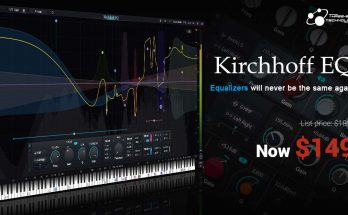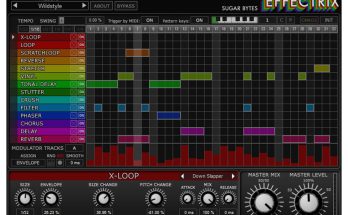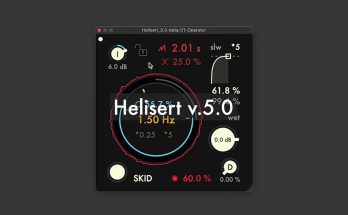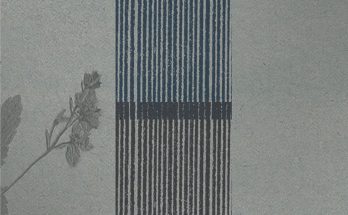Kirchhoff-EQ is the ultimate 32-band parametric equalizer designed for all critical professional applications. It features improved sound quality consistent with analog curves, 15 smoothly shaped filter types, and 32 classic EQ types modeled from real devices. The built-in dynamics processing functions are very flexible and have ultra-low distortion. All of this pushes the Kirchhoff-EQ to the next generation standard. Equalizers will never be the same again.
Robust Nyquist-consistent conversion.
With the originally developed “Reliable Nyquist Matched Conversion”, Kirchhoff-EQ has made the frequency response in the digital domain closer to its analog counterparts without the high frequency limitations of conventional IIR (infinite impulse response) equalizers. This method applies to all filter types in Kirchhoff-EQ.
High precision processing.
The 64-bit version is mandatory and non-negotiable. Kirchhoff-EQ’s internal processing is always done in 64-bit (or 117-bit) format, regardless of the host’s current DAW precision.
Topologies of psychoacoustic adaptive filters
All line filter structures should have the same sound on paper. However, in real applications, rounding errors cause each filter structure to sound different: some are better at low frequencies, some are better at high frequencies.
A technology called “Psychoacoustic Adaptive Filter Topologies” has been deployed at Kirchhoff-EQ. The filter structures move into a “best fit” state with corresponding band frequency changes, resulting in optimized sound quality at both low and high frequencies.
Switchable ultra-high 117-bit processing.
Since there are already 64-bit versions, why not go further? Kirchhoff-EQ uses a technique called “Double-Double” to achieve 117-bit internal processing accuracy! This is the first equalizer in the world to achieve such accuracy. You can switch between 64-bit and 117-bit at any time. It will satisfy the most demanding ears.
- Linear phase always uses 64 bits because it is a FIR (finite impulse response) filter and does not support 117 bits.
Filter types.
15 unique filter types
Low-pass, high-pass, band-pass: stepless adjustment from 0 dB/octave to 96 dB/octave;
call, notch: stepless adjustment from 12 dB / octave to 96 dB / octave;
low shelf, high shelf, sloping shelf: infinitely adjustable from 6 dB/octave to 96 dB/octave; 32 filter types modeled after historical vintage EQs!
flat slope and flat top;
sword: has a sharper slope than a bell, specifically designed to “dig out” resonances.
bottom brick wall pass, upper brick wall pass, low allpass and high allpass.
Smoothly variable slopes Filters.
The slope of most types of filters can be smoothly changed from 0 dB/octave, 6 dB/octave or 12 dB/octave to 96 dB/octave. Would you like to try the 8.125 dB/oct high pass filter?
Get vintage and modern at the same time! We have modeled 9 vintage hardware EQ blocks, for a total of 32 EQ types implemented in Kirchhoff-EQ. Benefit from robust Nyquist conversion: each EQ type closely matches the source equipment and will not compress near the Nyquist frequency. As a next step, unlike the original hardware which only allows you to choose between a few frequency positions, we have modified the DSP model to make adjustable frequency points for all of these types! Each type in these models can be used with regular EQ types or other modeled types, and can also be used with dynamic functions (except bass and treble types). This gives you more freedom and convenience to work.
*Nonlinear behavior not simulated. All types of vintage filters contain only the ideal linear parts of their physical model.
Zero delay/analog/linear/mixed phase modes.
The Kirchhoff-EQ’s phase mode can be switched between zero latency mode, analog mode, linear phase mode and mixed phase mode to suit all your phase relationship needs.
- Regardless of which phase mode is currently in use, if dynamic features are enabled for a filter band, it will operate in minimum phase mode (will not affect other bands).
Mixed phase regime.
Zero latency and linear phase modes sound very different. Kirchhoff-EQ provides a mixed mode that uses zero delay when the bandwidth point is low and uses linear phase when it is high. Each band can smoothly switch between minimum and linear phase according to their frequency.
- There is no noticeable crossover between filter types, while in mixed phase mode the transition is smooth. The dynamic features in the Kirchhoff-EQ are not just a bonus, they provide the richest features you’ve ever seen. Allows you to achieve the unlimited possibilities of dynamic EQ functions. All types of filters (except low-pass/high-pass, bandpass and notch), even these vintage ones, can be used with dynamic functions.
Flexible dynamic EQ functions.
Envelope with harmonic shift.
All dynamic equalizers have odd and non-integer harmonics, these are the laws of physics. Using advanced DSP techniques, Kirchhoff-EQ now “shifts” most of the energy from odd harmonics into even harmonics, creating ultra-low noise and enhancing the sound. Now you can freely use the dynamic features without worrying about ruining your sounds. Now you can simultaneously control how the speakers respond to the above/below threshold part of the signal. In the Kirchhoff-EQ, the High stage works as a compressor or upstream expander, and the Down stage works as an expander or upstream compressor. For example, you can boost the signal below the threshold AND compress the signal above the threshold to “stabilize” the band.
Bilateral threshold.
Relative envelope detection/detection.
Let’s imagine a simple case: we’re playing an audio clip where sounds around 1kHz are 9dB. You might be thinking, “The 1kHz band is overloaded, we should cut it down to 1kHz.” But we must also consider the overall level. If the whole sound is 30dB you won’t feel like 1kHz is too much, instead you might feel like it’s not enough. The best criterion for determining whether a band’s loudness is high or low is its relative contribution to the overall loudness envelope, not just its absolute dB value.
So in Kirchhoff-EQ we introduce “Relative Envelope Detection/Detection”. Dynamics is affected by both the current bandwidth and the relative portion of the “relative” bandwidth. The contribution of Relative Envelope Detection to dynamics is also configurable: when set to 0%, it degrades like a normal dynamic EQ; and with a value of 100%, the amount of dynamics is fully calculated from the relative share.
The “detect” band is set according to the frequency and Q factor of the default band, “Relative” is the entire audio envelope by default. But they can be installed freely.
Detection bandwidth and relative bandwidth have freely adjustable frequency point and Q value. Or turn on “SC” mode to use “Detection” or “Relative” with side chain signal.
Seizure detection mix.
When the “Onsets” mix is turned on, the envelope detector reacts more specifically to transients within the envelope. This way you can fine-tune the tone of the transients. For better customization, you can “mix” the envelope detector and the start detector. For example, you can compress the high frequencies a bit, while compressing the sharp rise in the high frequencies more aggressively.
PROPER – NO HOMECALLING – AAX(MODIFIED) INCLUDED.
- Uninstall any previous version.
- Run our installer.
Protection: VMProtect.
PROPER – NO HOMECALLING – AAX (MODIFIED) ON.
- Remove any previous version.
- Run our installer.
Protection: VMProtect.




